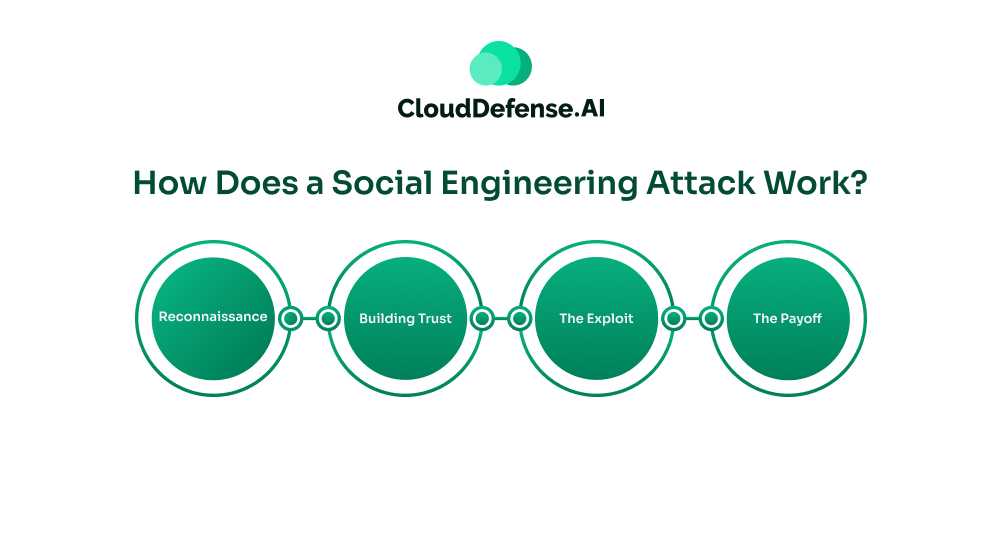So, What Exactly Is A Social Engineering Attack?
Social engineering, unlike brute-force hacking attempts, doesn’t target computer systems directly. Instead, it cleverly manipulates people. In other words, it’s like using deception and manipulation to trick people into revealing sensitive data or granting access they shouldn’t. Social engineers rely heavily on human psychology – they exploit:
- Trustworthiness
- Fear
- Curiosity
- Helpfulness
…to achieve their goals.
The creativity and planning behind social engineering attacks can be quite sophisticated. Attackers thoroughly research their targets through public sources and social media. They craft very believable pretexts and travel great lengths to appear trustworthy. And the best social engineers are master psychologists adept at:
- Reading people
- Molding their approach accordingly
While social engineering has been around forever, the internet and modern technology have opened up terrifying new avenues for scale and effectiveness. A well-executed social engineering campaign can potentially compromise an entire organization.
Types of Social Engineering Attacks

Social engineering comes in many flavors, each designed to exploit specific human vulnerabilities. Here’s a breakdown of some common types:
Phishing
The most well-known tactic. Phishing emails (or messages) appear to be from a legitimate source (bank, social media platform, etc.) and try to trick you into clicking a malicious link or downloading an attachment containing malware.
Example: You receive an email that looks like it’s from your bank, warning of suspicious activity on your account. The email prompts you to click a link to “verify” your information. Clicking the link takes you to a fake bank login page designed to steal your credentials.
Spear Phishing
Spear Phishing is more targeted version of phishing. Attackers gather specific information about their victims beforehand to make the emails seem more believable.
Example: An attacker might research the employees of a specific company and then send emails tailored to each person’s role. An email to the finance department might mention a fake invoice that needs urgent processing.
Pretexting
Involves creating a fake scenario to gain your trust and personal information. The attacker pretends to be someone you would expect to hear from, like a customer service representative or law enforcement officer.
Example: You receive a call from someone claiming to be from your internet service provider. They inform you of a billing issue and ask for your account information to “resolve” the problem.
Baiting:
Lures victims with irresistible offers or exploits curiosity. This could be a free download, a too-good-to-be-true discount code, or even a physical USB drive left in a public place.
Example: You find a USB drive labeled “Payroll” lying on the ground near your office building. Curiosity might lead you to plug it into your computer, infecting it with malware.
Quid Pro Quo
The attacker gratifies the victim’s greed by offering something of value in exchange for the sensitive data or access they want.
Example: You receive a pop-up message warning you of a virus infection on your computer. A phone number is provided for “immediate assistance.” The “technician” remotely connects to your system and convinces you to download security software (which is actually malware).
How Does a Social Engineering Attack Work?

Social engineering attacks follow a general pattern, though the specific methods used can vary considerably. The first step is information gathering – attackers collect as much publicly available data as possible about their target individual or organization.
1. Reconnaissance: In Reconnaissance phase, the attacker gathers information about you. This could involve scouring your social media profiles, phishing for details through emails, or even buying stolen data on the dark web.
2. Building Trust: Armed with this intel, the attacker tailors their approach. They might pose as a helpful IT person, a concerned colleague, or a representative from a familiar company. They’ll use a friendly tone, urgency (think “urgent security breach!”), or even flattery to gain your trust.
3. The Exploit: Once they have your trust, they’ll launch their exploit. This could be:
- Phishing: A fake email or website designed to steal your login credentials or personal information.
- Vishing: A phone call impersonating a legitimate company to trick you into divulging sensitive details.
- Quid pro quo: Offering fake technical support in exchange for remote access to your computer.
- Baiting: Luring you with a seemingly irresistible offer or a sense of urgency to click a malicious link or download an infected file.
4. The Payoff: Social engineering attacks follow a general pattern, though the specific methods used can vary considerably. The first step is information gathering – attackers collect as much publicly available data as possible about their target individual or organization.
The human element is what makes these attacks so dangerous. We all like to be helpful and tend to trust certain authority figures or pretexts. Overcoming those natural instincts is hugely challenging but critical for security.
Why Social Engineering Attacks Work: Exploiting Our Psychology
On the surface, many social engineering attacks seem obvious—we’re taught from an early age not to trust strangers or give out personal information. Yet these schemes remain incredibly effective for a few key reasons:
- Trust and Authority: We’re wired to trust figures of authority and people who seem familiar. Attackers exploit this by impersonating trusted sources like banks, IT professionals, or even colleagues.
- Urgency and Fear: Many pretexting attacks play off the fear of getting caught doing something wrong. If told there’s a “problem” with our account or device, our knee-jerk reaction is to resolve it as quickly as possible rather than question the circumstances.
- Greed and Curiosity: The promise of a reward or the allure of uncovering something hidden can be tempting. Attackers dangle irresistible offers or play on our curiosity to lure us into clicking malicious links or opening attachments.
- Social Norms: We often feel obligated to help others or respond to requests, especially from those we perceive as authority figures. Attackers manipulate this by framing their requests as needing your help or exploiting your desire to be helpful.
- Lack of Awareness: Many people are unaware of social engineering tactics. They might not recognize the red flags in emails or phone calls, making them more susceptible to manipulation.
At the end of the day, social engineering preys on the very qualities that make us human – our inclination to trust, fear of consequences, reliance on perceived indicators of credibility, and cognitive lapses. Maintaining a constant awareness is the only way to overcome these psychological blind spots.
How to Prevent Social Engineering Attacks?
| Social Engineering Prevention Tips | Description |
| Be cautious of emails, messages, or social media posts with links or attachments | Don’t click on anything that seems too good to be true or creates a sense of urgency. |
| Verify sender legitimacy | Don’t trust caller ID alone. If unsure, contact the sender through a trusted channel (e.g., phone number from the company website). |
| Be wary of unsolicited calls and messages | Don’t give out personal information or financial details over the phone or through messages unless you initiated the contact. Legitimate companies won’t pressure you for immediate action or threaten to suspend your account. |
| Strong passwords and MFA | Use strong, unique passwords for all your online accounts and enable Multi-Factor Authentication (MFA) whenever possible. MFA adds an extra layer of security by requiring a second verification code when logging in. |
| Keep software updated | Keep your operating system, antivirus software, and web browser up to date with the latest security patches. Updates often include fixes for vulnerabilities that attackers can exploit. |
| Be skeptical and think before you act | Be skeptical of any unexpected communication, even if it appears to come from a trusted source. Take a moment to think critically before clicking on links, downloading attachments, or providing any personal information. |
| Report suspicious activity | Report suspicious emails, messages, or social media posts to the appropriate authorities. |
Real-World Social Engineering Attacks: Stealing Millions with a Click

Here are some chilling real-world examples of how social engineering attacks have caused major damage:
The $100 Million Google and Facebook Scam: In a clever scheme, Lithuanian Evaldas Rimasauskas created a fake company posing as a supplier to Google and Facebook. Through meticulously crafted email exchanges, he convinced employees of both tech giants to transfer millions into fraudulent bank accounts. This attack highlights the effectiveness of spear phishing, targeting specific individuals with believable information.
The Bangladesh Bank Heist (2016): In one of the largest cyber thefts in history, hackers used a combination of social engineering and malware to steal $81 million from the Bangladesh Bank. They reportedly tricked bank employees into authorizing fraudulent transactions through a series of phishing emails and watering hole attacks (compromising legitimate websites to infect visitors).
The Sony Pictures Hack (2014): A group calling themselves “Guardians of Peace” launched a social engineering attack to steal confidential information from Sony Pictures. They gained access to the company network through a relatively simple tactic: spear phishing emails with malware-laden attachments sent to Sony employees.
These are just a few examples, but they showcase the reach and potential devastation of social engineering attacks. By understanding these tactics and implementing strong security measures, we can all become more resilient in the digital age.
Final Words
Social engineering attacks aren’t limited to tech giants or anonymous hackers. Anyone can be a target. These manipulative tactics exploit our very human nature, and the consequences can be devastating. From stolen identities to financial ruin, the stakes are high.
Therefore, be vigilant. Question everything. Don’t click, don’t download, and don’t share sensitive information without verification. Remember, even a single click can have devastating consequences. The digital world is a battlefield, and your awareness is your strongest defense.







